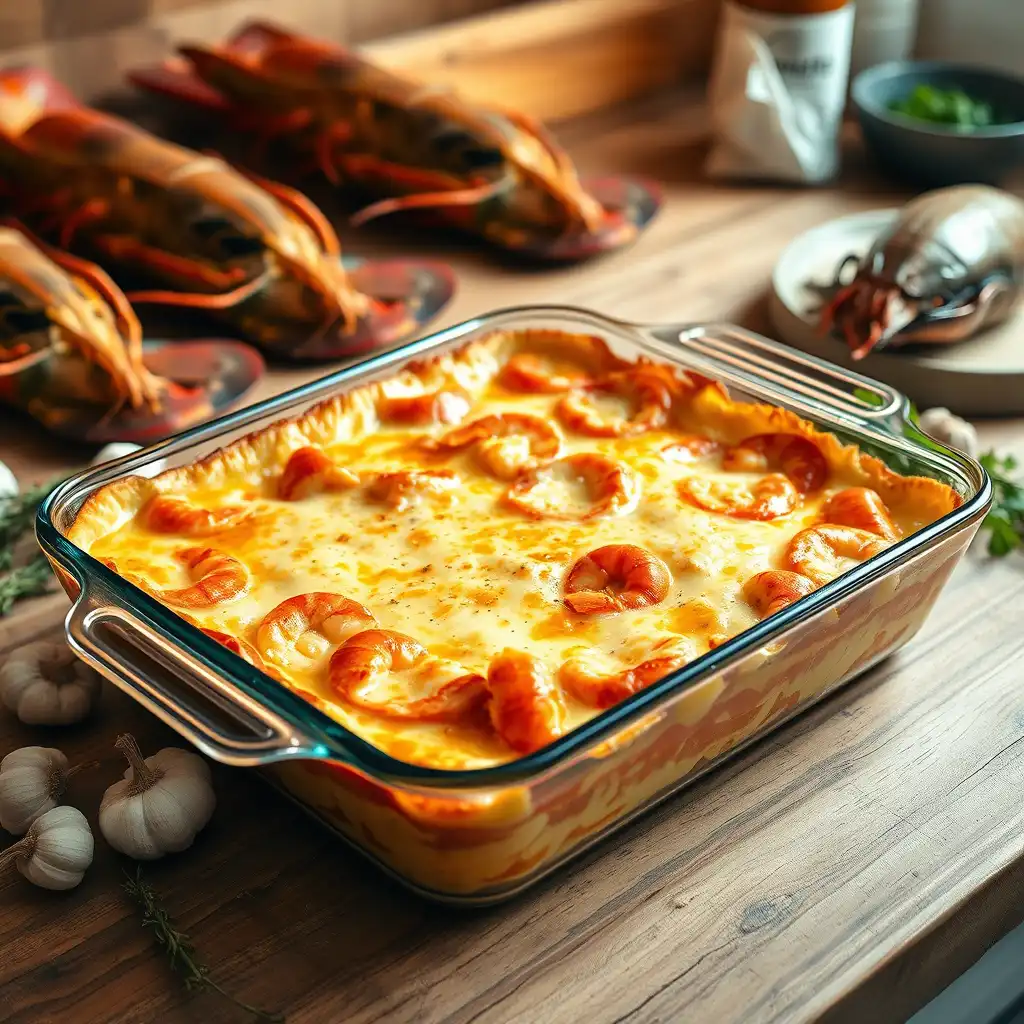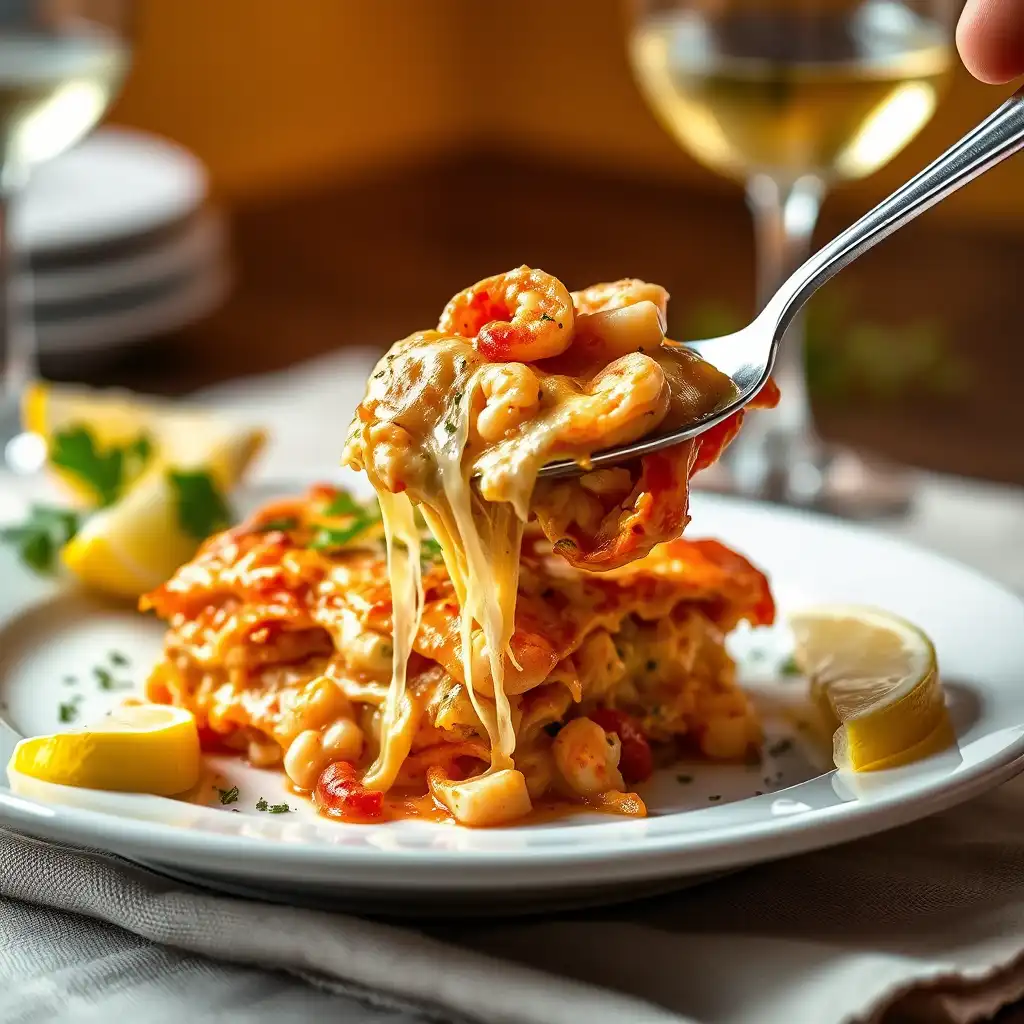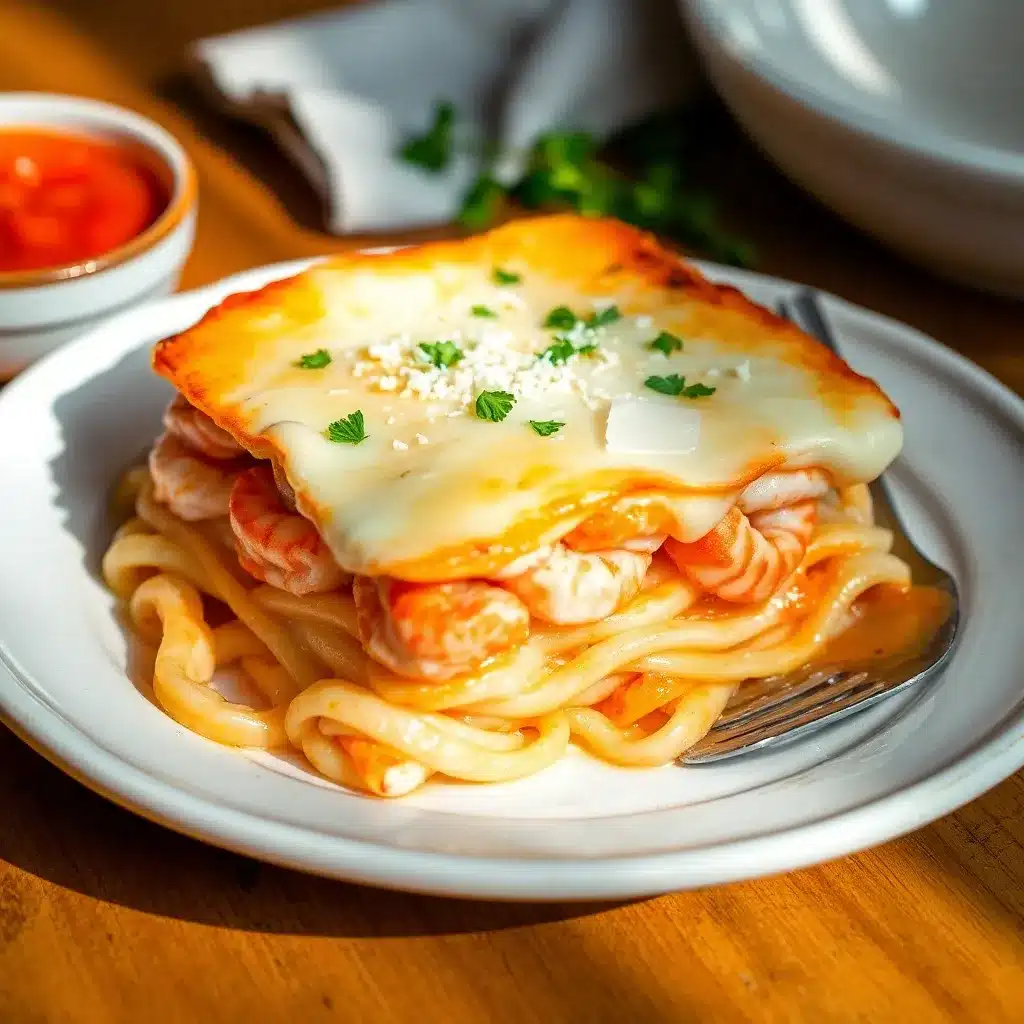Ever had a dish so rich it almost feels like a secret whispered between chefs? That’s the kinda magic happening with Ultimate Seafood Lasagna with Lobster and Shrimp. Imagine layers of tender pasta, sweet lobster, juicy shrimp, and creamy béchamel, all melded in a symphony of flavors that sings of the sea. This ain’t your everyday lasagna; it’s a luxe, showstopper meal that demands some patience, finesse, and a serious love for seafood.
This recipe stands apart ‘cause it’s not just lasagna with some seafood tossed in. Nah, it’s crafted with attention to detail—a perfect balance of texture, flavors, and technique. The lobster is poached just right, the shrimp gently sautéed, and the béchamel is silky but with just enough body to hold everything together. Plus, a hint of white wine and fresh herbs that tease the palate. It’s got a nod to Italian tradition but also a splash of modern elegance. If you’re a pro or even an ambitious home cook wanting to impress, this seafood lasagna’s your ticket.
Ingredients & Substitutions
- Fresh Lobster Tails (2 large) – You want fresh, not frozen, if possible. Fresh lobster has that sweet, delicate texture that just can’t be matched.
- Shrimp (12 medium, peeled and deveined) – Wild-caught is ideal; they’ve got a firmer bite and more flavor than farmed shrimp.
- Lasagna sheets (fresh if you can find ‘em) – Fresh pasta cooks faster and stays tender, but no shame if you go dried.
- Butter (4 tbsp) – Unsalted, to control saltiness.
- All-purpose flour (3 tbsp) – This makes the béchamel, but if you want a lighter version, try substituting with rice flour for gluten-free.
- Whole milk (3 cups) – Fresh and cold milk creates a creamy béchamel.
- Parmesan cheese (1 cup, grated) – Freshly grated, never pre-grated. The difference in flavor and melting is wild.
- Mozzarella (1.5 cups, shredded) – Go for low-moisture mozzarella to avoid a watery lasagna.
- Garlic (3 cloves, minced) – Fresh and finely minced.
- Shallots (2, finely diced) – Adds subtle sweetness.
- White wine (½ cup, dry) – Helps deglaze and adds acidity, balancing richness.
- Fresh parsley and thyme (2 tbsp each, chopped) – Use fresh herbs for brightness. Dried will work but lose a bit of that fresh punch.
- Salt and freshly cracked black pepper – To taste.
- Olive oil (2 tbsp) – Extra virgin, cold-pressed.
Substitutions and Insights:
If lactose is an issue, swap whole milk with unsweetened almond or oat milk, and use a vegan butter substitute. For shellfish allergies, you could try scallops or firm fish like cod, but you lose that sweet richness lobster brings. Fresh herbs trump dried for vibrant flavor; dried herbs tend to concentrate and sometimes get bitter when cooked too long. For flour, high-protein (bread) flour will make béchamel gummy, so stick with all-purpose or alternative flours mentioned.

Step-by-Step Instructions
Step 1: Preparing the Lobster and Shrimp
Bring a large pot of salted water to a boil. Drop the lobster tails in for about 5 minutes until just opaque—don’t overcook or they turn rubbery. Remove, cool, then slice the meat into chunks. For shrimp, sauté in a hot pan with olive oil, garlic, and shallots until pink and just firm. Toss in half the fresh herbs and a pinch of salt. Set aside.
Step 2: Make the Béchamel Sauce
Melt butter in a saucepan over medium heat. Stir in flour and cook for about 2 minutes without browning (this cooks out the raw flour taste). Slowly whisk in cold milk, continuously stirring to avoid lumps. Let it thicken gently, then add salt, pepper, and half the parmesan. If the sauce’s too thick, a splash more milk helps loosen it.
Step 3: Assemble the Lasagna
Lightly oil your baking dish. Lay a thin layer of béchamel on the bottom, then a layer of pasta sheets. Spread half the lobster and shrimp evenly, then drizzle some white wine over it. Add a generous amount of béchamel and sprinkle mozzarella and some parmesan. Repeat with another pasta layer, seafood, béchamel, and cheese. Top with a final layer of pasta, béchamel, and cheese.
Step 4: Baking
Preheat oven to 375°F (190°C). Cover the dish loosely with foil to prevent the top from burning. Bake for about 30 minutes, then remove foil and bake another 15 minutes until golden and bubbling. Let it rest 10 minutes before serving to let the layers set.
Expert Tips: Don’t rush the poaching—overcooked lobster or shrimp kills the texture. When whisking béchamel, patience prevents lumps; adding milk slowly is key. Avoid watery lasagna by using low-moisture cheese and draining excess liquid from seafood. Want it spicy? Add crushed red pepper flakes when sautéing shrimp.
Cooking Techniques & Science
Why bother making béchamel from scratch? It’s all about control. Homemade béchamel brings a creamy, unctuous texture that canned or boxed versions can’t mimic. The roux (butter and flour mixture) cooks the starch, which thickens the milk and creates a velvety sauce that clings perfectly to the pasta and seafood.
Poaching lobster in salted water gently cooks the meat while locking moisture inside. If you boiled it hard, you’d end with tough rubbery bites. Sautéing shrimp with aromatics (garlic, shallots) infuses the crustacean with flavor without drying it out.
The layering technique is crucial for even cooking and flavor melding. Pasta sheets act as a sponge soaking up béchamel and seafood juices, while cheese melts into pockets of molten goodness. Covering the lasagna during baking traps steam, cooking everything evenly, and removing the cover in the last stretch crisps the top beautifully.
Using fresh herbs introduces volatile oils that lift the seafood’s natural sweetness. White wine’s acidity cuts through richness, balancing the dish’s heavy components.
Important tools? A whisk for béchamel to avoid lumps, a sharp chef’s knife to slice seafood neatly, and a good-quality baking dish that distributes heat evenly. A heavy-bottomed pan for sautéing prevents hot spots and burning.
Serving & Pairing Suggestions
Plate your Ultimate Seafood Lasagna with a sprinkle of fresh parsley and a few lemon wedges on the side for a citrus burst. Serve with a simple arugula salad dressed lightly in lemon and olive oil to refresh the palate. A chilled glass of crisp Pinot Grigio or Sauvignon Blanc pairs beautifully, echoing the wine notes in the lasagna.
For sides, consider roasted asparagus or sautéed green beans with garlic. The green veggies bring a crunch contrast and a touch of bitterness that plays well against the rich seafood layers.
Presentation-wise, cut neat squares, wipe edges clean, and serve on warm plates to keep everything cozy. A drizzle of high-quality olive oil on top before serving adds gloss and extra flavor.

Conclusion
Ultimate Seafood Lasagna with Lobster and Shrimp is a decadent blend of textures and flavors that elevates a classic dish into a gourmet experience. The success lies in technique—perfectly cooked seafood, smooth béchamel, and balanced seasoning. It’s a dish that demands respect but rewards with unforgettable taste.
Don’t skimp on quality ingredients, take your time layering, and watch your heat carefully. This lasagna can become your signature dish, impressing guests and satisfying even the most discerning seafood lover. Feel free to tweak spice levels or herbs, but keep the core method intact for best results.
FAQs
How do I prevent the lasagna from becoming watery?
Use low-moisture cheeses, drain seafood well before layering, and don’t overload béchamel with too much milk. Also, cover during baking and uncover near the end to allow moisture evaporation.
Can I prepare this lasagna ahead of time?
Yes! Assemble it and refrigerate for up to 24 hours before baking. Just add 10-15 minutes to the baking time if going straight from the fridge.
What’s the best way to reheat leftovers?
Reheat in an oven at 350°F (175°C) covered with foil to retain moisture. Avoid microwave to prevent uneven heating and rubbery seafood.
Can I substitute lobster with crab or scallops?
Absolutely, but note crab has a softer texture and scallops cook faster—adjust cooking times to avoid overcooking.
Is it okay to use dried herbs if fresh aren’t available?
You can, but reduce quantity by half as dried herbs are more concentrated and can become bitter if overcooked.

Olivia P. is a seasoned food blogger at Tastywink, sharing delicious, easy-to-follow recipes inspired by him passion for home cooking. With years of culinary blogging experience, he brings flavor, creativity, and a personal touch to every dish.
